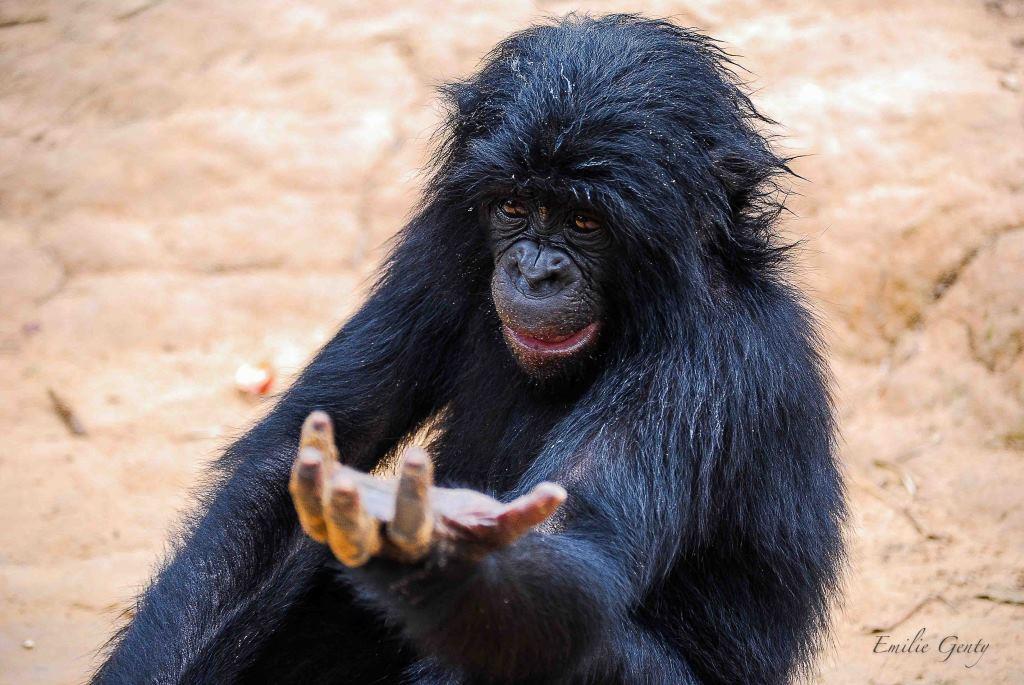Emilie Genty
Research interests
Multimodal communication and coordination of joint action in apes: Bonobos (Pan paniscus) and chimpanzees (P. troglodytes)
My research interest lies in the study of non-human primates multimodal communication with a special emphasis on gestures. Through the comparative study of great apes’ communication we are looking for the presence of precursor abilities of human language. I am specifically looking at the way apes convey specific social goals by using combinations of communicative signals and how these combinations vary according to the social context, the signaler’s goal and the recipient’s identity.
My current research project concerns the study of joint activities coordination in chimpanzees (Pan troglodytes) and bonobos (P. paniscus). With this study, we hope to shed light on the evolutionary origins of human shared intentionality, a special intrinsic motivation to share experiences and mental states with others. It has been suggested that shared intentionality has emerged in response to problems faced in spontaneous joint action coordination and is a uniquely human capacity. However, by studying how our closest relatives, the great apes, engage in and coordinate joint action with conspecifics, we might demonstrate some correlate abilities of shared intentionality, such as the appreciation of joint commitment.This research is part of an FNS interdisciplinary project involving primatologists and human interaction specialists and is the result of the collaboration between the Department of Comparative Cognition and the Institute of Work and Organizational Psychology
http://avisdexperts.ch/experts/emilie_genty

Publications
2020
Genty. E, Hessen R., Rossano F., et al. How apes get into and out of joint actions: Shared intentionality as an interactional achievement. Interaction Studies (in press).
2019
Genty E. (2019) Vocal-gestural combinations in infant bonobos: new insight into signal functional specificity. Animal Cognition. Anim Cogn 22: 505. https://doi.org/10.1007/s10071-019-01267-0
Shorland G., Genty E., Guéry J.P., Zuberbühler K. (2019) Social learning of arbitrary food preference in bonobos. Behavioral Processes, Vol 167.https://doi.org/10.1016/j.beproc.2019.103912
2017
Clay Z., and Genty, E. (2017) Natural communication in bonobos: insights into social awareness and the evolution of language. In: Bonobos. Unique in Mind, Brain and Behaviour (eds. B. Hare and S. Yamamoto). Oxford University Press.
Byrne, R. W., Cartmill, E., Genty, E., Graham, K.E., Hobaiter, C., &Tanner, J. (2017). Great ape gestures: intentional communication with a rich set of innate signals. Animal Cognition, 1-15.
Heesen, R., Genty, E., Rossano, F., Zuberbühler, K., & Bangerter, A. (2017) Social play as a joint action: A framework to study the evolution of shared intentionality as an interactional achievement. Learning & Behaviour, 1-16.
2015
Genty, E., Neumann, C., & Zuberbühler, K. (2015). Complex patterns of signalling to convey different social goals of sex in bonobos, Pan paniscus. Scientific Reports, 5.
Genty, E., Neumann, C., & Zuberbühler, K. (2015). Bonobos modify communication signals according to recipient familiarity. Scientific Reports, 5.
2014
Genty, E., Clay, Z., Hobaiter, C., & Zuberbühler, K. (2014). Multi-Modal Use of a Socially Directed Call in Bonobos. Plos One, 9(1).
Genty, E., & Zuberbühler, K. (2014). Spatial Reference in a Bonobo Gesture. Current Biology, 24(14), 1601-1605.

Emilie Genty
Scientific Coordinator
+41 32 718 2113
Université de Neuchâtel
Institut de Biologie
Cognition Comparée
Rue Emile-Argand 11
2000 Neuchâtel
Bureau E227, Bâtiment E

